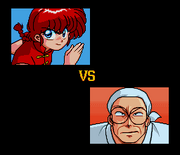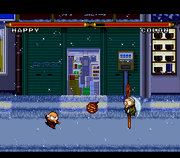m (Cleanup of Characters section) |
No edit summary |
||
| Line 1: | Line 1: | ||
| − | {{Stub}} |
||
{{Infobox Video Game |
{{Infobox Video Game |
||
|image = [[File:Chōnai Gekitōhen cover.gif|230px]] |
|image = [[File:Chōnai Gekitōhen cover.gif|230px]] |
||
| Line 17: | Line 16: | ||
==Overview== |
==Overview== |
||
| + | [[Ranma Saotome|Ranma]] learns of a martial arts tournament in which the grand prize is a invitation to see China. Desperate to rid himself of his [[Jusenkyo]] curse, Ranma decides to enter the tournament, but the other characters also hear of the tournament and decide to enter as well to either hope to rid themselves of their own curses, or to simply cause Ranma trouble. |
||
==Gameplay== |
==Gameplay== |
||
| + | [[Image:Gekitōhen versus screen.png|thumb|left|The versus screen in ''Chōnai Gekitōhen''.]] |
||
| + | The story mode includes three difficultly settings, "Easy", "Normal" and "Hard and Super", but the difficultly setting doesn't alter any of ending credits, however, the ending picture will change depending on which form Ranma was in after defeating [[Ryoga Hibiki|Ryoga]]. Ranma is the only playable character in the story mode, unless the player holds the top "L" and "R" buttons before pressing start which allows the player to chose to play as one of Ranma's opponents (the "A" button will also need to pressed if the character chosen is the same as the opponent, for example Shampoo vs. Shampoo, etc). However, no matter which character is chosen, Ranma will still appear in the ending picture. |
||
| + | There are two bonus stages in the story mode, the first being after fighting [[Kodachi Kuno|Kodachi]], where the player has to hit [[Happosai]] ten times before he runs away which awards the player another "continue". The second bonus occurs after fighting [[Principal Kuno]] and involves the player hitting any combination of ten bowls of Ramen and Sweet chestnuts thrown by [[Cologne]] before the time runs out, again the player is awarded another "continue" on completion. |
||
| + | |||
| + | [[Image:Gekitōhen - Happy and Cologne.gif|thumb|Happosai and Cologne in two player mode.]] |
||
| + | Similar to in story mode, in two player mode, when holding down "L" and "R" before pressing start will unlock both Happosai and Cologne as playable characters. |
||
| + | |||
| + | On the default control settings, "X" preforms jumps with "Y" and "B" for normal attacks whilst "A" perform special attacks whilst the "L" or "R" buttons are used for blocking. The jump and attack buttons can be rearranged in any way, but the jump button cannot be moved over to the directional pad, which is a common complaint amongst fans.<ref>[http://stevethefish.net/superfamicom/ranmanc/ranmanc.htm stevefish.net]</ref><ref>[http://www.vgmuseum.com/reviews/snes/sc/ vgmuseum.com]</ref> |
||
| + | |||
| + | ==Western Release== |
||
| + | [[Image:Gekitōhen-Combat comparison.png|thumb|left|A comparison between ''Chōnai Gekitōhen'' (left) and ''Street Combat'' (right).]] |
||
| + | ''Chōnai Gekitōhen'' was licensed and released {{W|Irem}} in 1993. However, as this was a few years before anime and manga hit the American mainstream,<ref>[http://www.hardcoregaming101.net/ranma/ranma.htm hardcoregaming102.net]</ref> Irem chose to alter the game into a more "American-friendly" title and changed almost every aspect of the game, releasing it under the name "Street Combat". ''Street Combat'' replaces all the ''[[Ranma ½]]'' characters with more "typical" American superheroes, altering character sprites and in-game artwork, although the controls remain the same as in ''Chōnai Gekitōhen''. The most extreme of these changes is arguably Kodachi's character, who is replaced by a male clown named "Dozo". |
||
==Characters== |
==Characters== |
||
| Line 66: | Line 78: | ||
==References== |
==References== |
||
| + | {{Referencebox}} |
||
| − | <references/> |
||
==External Links== |
==External Links== |
||
| − | *[http://ja.wikipedia.org/wiki/らんま1/2_町内激闘篇 らんま1/ |
+ | *[http://ja.wikipedia.org/wiki/らんま1/2_町内激闘篇 らんま1/2 町内激闘篇 on Japanese Wikipedia] |
*[http://www.hardcoregaming101.net/ranma/ranma.htm Hardcore Gaming 101 entry for all three fighting games] |
*[http://www.hardcoregaming101.net/ranma/ranma.htm Hardcore Gaming 101 entry for all three fighting games] |
||
{{DEFAULTSORT:Chonai Gekitohen}} |
{{DEFAULTSORT:Chonai Gekitohen}} |
||
Revision as of 15:23, 25 June 2012
Ranma ½: Chōnai Gekitōhen (らんま1/2 町内激闘篇?) is a 2-D fighting game released by Masaya and Irem for the Super Nintendo Entertainment System. The game holds the distinction of not only being the first Ranma ½ game for the SNES, but also the first ever Ranma ½ game released.[1] The title roughly translates to "Ranma ½: Neighborhood Combat Chapter" and is also the only game in which Cologne appears.
Since it's release the Chōnai Gekitōhen has become quite well known for how, when it was released in America, the game was renamed "Street Combat" and westernised extensively; with every Ranma ½ character replaced by a more "typical" Western Superhero.
Overview
Ranma learns of a martial arts tournament in which the grand prize is a invitation to see China. Desperate to rid himself of his Jusenkyo curse, Ranma decides to enter the tournament, but the other characters also hear of the tournament and decide to enter as well to either hope to rid themselves of their own curses, or to simply cause Ranma trouble.
Gameplay

The versus screen in Chōnai Gekitōhen.
The story mode includes three difficultly settings, "Easy", "Normal" and "Hard and Super", but the difficultly setting doesn't alter any of ending credits, however, the ending picture will change depending on which form Ranma was in after defeating Ryoga. Ranma is the only playable character in the story mode, unless the player holds the top "L" and "R" buttons before pressing start which allows the player to chose to play as one of Ranma's opponents (the "A" button will also need to pressed if the character chosen is the same as the opponent, for example Shampoo vs. Shampoo, etc). However, no matter which character is chosen, Ranma will still appear in the ending picture.
There are two bonus stages in the story mode, the first being after fighting Kodachi, where the player has to hit Happosai ten times before he runs away which awards the player another "continue". The second bonus occurs after fighting Principal Kuno and involves the player hitting any combination of ten bowls of Ramen and Sweet chestnuts thrown by Cologne before the time runs out, again the player is awarded another "continue" on completion.

Happosai and Cologne in two player mode.
Similar to in story mode, in two player mode, when holding down "L" and "R" before pressing start will unlock both Happosai and Cologne as playable characters.
On the default control settings, "X" preforms jumps with "Y" and "B" for normal attacks whilst "A" perform special attacks whilst the "L" or "R" buttons are used for blocking. The jump and attack buttons can be rearranged in any way, but the jump button cannot be moved over to the directional pad, which is a common complaint amongst fans.[2][3]
Western Release

A comparison between Chōnai Gekitōhen (left) and Street Combat (right).
Chōnai Gekitōhen was licensed and released Irem in 1993. However, as this was a few years before anime and manga hit the American mainstream,[4] Irem chose to alter the game into a more "American-friendly" title and changed almost every aspect of the game, releasing it under the name "Street Combat". Street Combat replaces all the Ranma ½ characters with more "typical" American superheroes, altering character sprites and in-game artwork, although the controls remain the same as in Chōnai Gekitōhen. The most extreme of these changes is arguably Kodachi's character, who is replaced by a male clown named "Dozo".
Characters
| Original Character Name | Street Combat Name | Notes |
|---|---|---|
| Ranma Saotome | Steven | To demonstrate the cursed form, "Steven" had two appearances, one with armour and one without. |
| Genma Saotome | Tyrone | |
| Kodachi Kuno | Dozo | |
| Tatewaki Kuno | G.I. Jim | |
| Principal Kuno | Helmut | |
| Shampoo | Lita | |
| Ryoga Hibiki | C.J. | Serves as the final boss of the Story mode. |
| Cologne | A hidden character who can only be played in Versus mode after putting in a code. | |
| Happosai | Happy | See above. |
References
